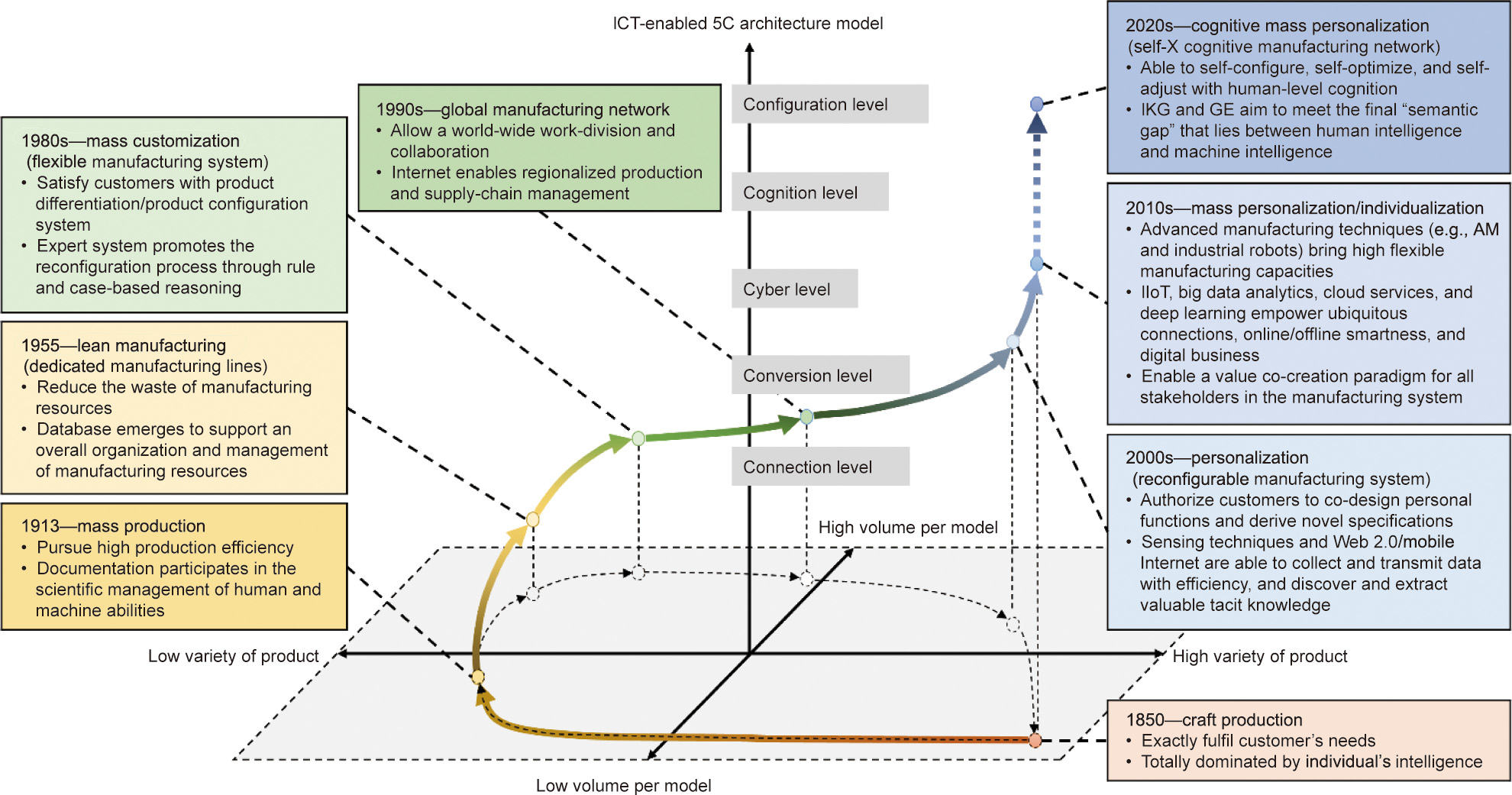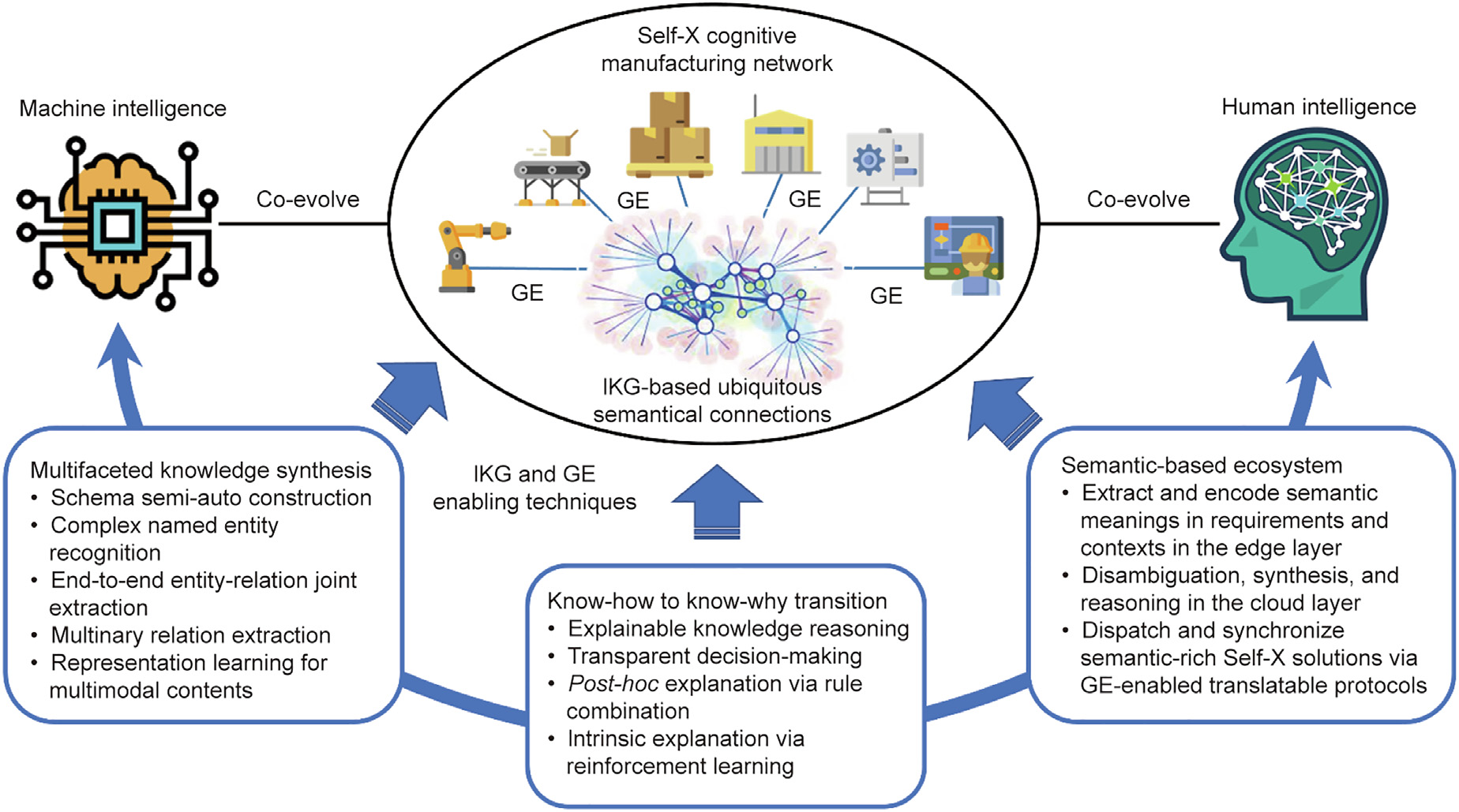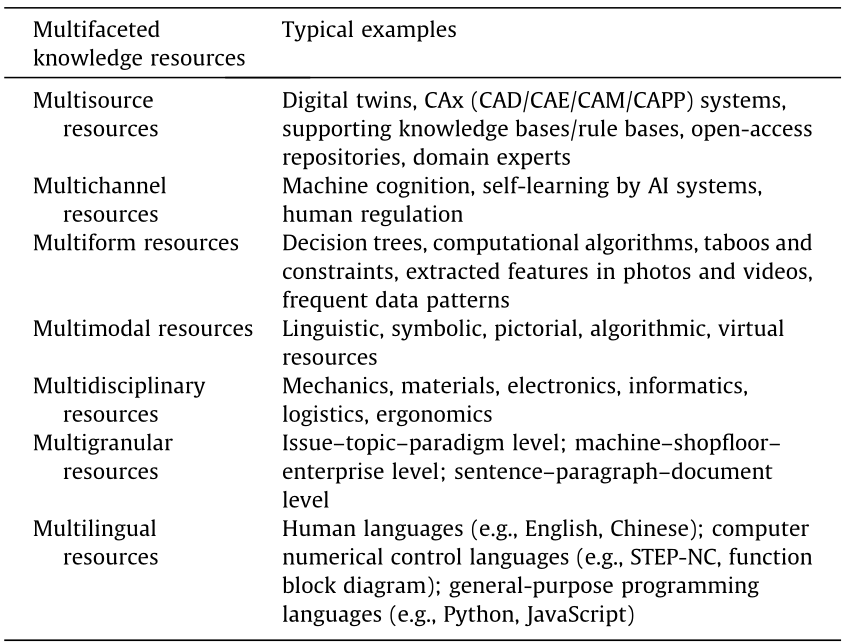《1. Introduction》
1. Introduction
Facilitated by cutting-edge information and communication technologies (ICTs), smart manufacturing is emerging as an overwhelming wave, reforming global manufacturing systems [1]. The ubiquitous connection and interoperability of manufacturing resources can be achieved through the Industrial Internet of Things (IIoT) [2,3], and the generated high volume, velocity, variety, veracity, and value (5V) of big data can be cost-effectively utilized with advanced data mining and deep learning techniques [4,5]. In this situation, responding to the massive, dynamic, and personalized customer requirements of mass personalization [6,7], the whole manufacturing system can be governed with an ever-increasing level of automation (i.e., ‘‘smartness”), approaching a so-called ‘‘Self-X” manufacturing network that is ‘‘self-aware, self-comparing, self-predicting, self-optimizing, and self-resilient” [8].
Nevertheless, a huge gap remains between current technologies and the ideal smartness level of a Self-X network. An attempt is underway to emphasize cognitive intelligence in manufacturing systems [9], which will allow machines to correctly understand, interpret, and respond to humans’ behaviors and instructions in a natural and timely manner. However, two main challenges have been identified in the incorporation of cognitive intelligence within industrial practices. One challenge is the lack of organization and networking based on semantic information among massive and heterogeneous manufacturing resources. This lack impedes knowledge from flowing fluently through machining modules, information systems, and stakeholders; it also obstructs the global management and evolvement of industrial knowledge in manufacturing scenarios [10,11]. The other challenge is the incomprehension and absence of trust between machines and humans-in-theloop (i.e., humans directly involved in machine–human interactions and systems) [12], because it is usually not possible for a machine to clearly communicate and persuasively explain to humans why it is making such a prediction or decision with the input data, based on its cognition and self-learning processes [13,14].
By organizing massive heterogeneous concepts with interconnected nodes and defining their arbitrary semantic relations with an ontology-based schema, the knowledge graph—especially the industrial knowledge graph (IKG), which is a specialized knowledge graph in an industrial scenario—holds promise for tackling the abovementioned challenges, with its innate high expandability and explainability [15]. Furthermore, as a key to this treasure house of knowledge, the graph embedding (GE) technique demonstrates strong capabilities to process complex semantic meanings. While retaining the graphical structure in an IKG, the GE technique represents nodes and edges with lower dimension vectors, thereby enabling a succession of rapid and efficient methods for concept representation, relation query, and knowledge reasoning [16]. However, even though IKGs and GE have been gradually recognized as the core for next-generation industrial management information systems [17], practitioners still regard them as a medium and tool for providing industrial information and only focus on proposing theories and methods to improve their technical performance [18]. Instead, this paper takes a systematic perspective and emphasizes the necessity of exploiting IKGs and GE to cognize every manufacturing workflow and bridge the semantic gap between humans and machines. To this end, a pathway empowered by IKGs and GE that introduces more cognitive intelligence for cognitive mass personalization is envisioned in Section 2. Section 3 then depicts three promising IKG- and GE-enabled technologies in a Self-X cognitive manufacturing network, and Section 4 highlights the opportunities and challenges in this field.
《2. A pathway to cognitive mass personalization》
2. A pathway to cognitive mass personalization
Today’s manufacturing paradigm is rapidly moving toward mass personalization to meet individualized on-demand manufacturing in a more cognitive and Self-X manner, by leveraging cutting-edge cognitive computing, IIoT, and big data analytics techniques. This section briefly illustrates the evolvement of manufacturing paradigms and then proposes a pathway to achieve the cognitive mass personalization paradigm.
《2.1. Evolvement of manufacturing system paradigms》
2.1. Evolvement of manufacturing system paradigms
Ever since the first industrial revolution, manufacturing has evolved in several paradigms in terms of its production variety (x-axis) and volume per model (y-axis), as shown in Fig. 1. The first paradigm was craft production, in which designs were produced for customers at a high cost and low production efficiency. Next, the emergence of dedicated manufacturing lines in the second industrial revolution introduced the paradigms of mass production and lean manufacturing, in which the business model provided very few types of products with higher efficiency and lower waste. More recently, with the prevailing implementation of the Internet/mobile Internet in the third industrial revolution, manufacturing systems with high agility, flexibility, and reconfigurability, together with online configuration systems, have enabled mass customization, in which customers can participate in the design to obtain a customized product at an affordable cost in mass efficiency [19]. Starting in 2010, with the ‘‘one-step-forward” integration of advanced manufacturing techniques (e.g., industrial robots and three-dimensional (3D) printing) and advanced ICT techniques (e.g., the IIoT and cloud services), the concepts of the single-customer market and customer-made design are becoming widely accepted as an ultimate goal of the fourth industrial revolution (i.e., Industry 4.0). We are now moving toward the paradigms of mass personalization [20] and mass individualization [21].
Moreover, the digital capabilities of modern manufacturing systems are being empowered to transform in a step-wise fashion to include cognitive capabilities [9]. Examples of these digital capabilities include:
• Networking: the ability to connect various manufacturing ‘‘things” (e.g., multi-aspect stakeholders, cognitive machining modules, traceable materials, digitalized manufacturing services, and the cyber-physical environment) through communication networks;
• Analytics: the ability to configure hardware components to sense and capture information with less human intervention;
• Intelligence: the ability to transform the data/information available into valuable insights and actionable directives [22].
This situation is benchmarked with the 5C (connection, conversion, cyber, cognition, and configuration) architecture model [23] depicting automation levels (z-axis) in Fig. 1. Based on the prevailing paradigm of mass personalization and inspired by the concept of self-organizing networks [24], a promising paradigm of cognitive mass personalization is anticipated. To achieve this paradigm, it is necessary to embrace the next-generation manufacturing system—that is, the Self-X cognitive manufacturing network, which includes the following features:
《Fig. 1》

Fig. 1. An evolvement pathway of manufacturing paradigms. 5C: connection, conversion, cyber, cognition, and configuration; AM: additive manufacturing.
(1) Self-configuration, which stands for automatic re-/configured manufacturing resources that can fulfill on-demand requirements in a ‘‘plug-and-play” manner via standardized hardware modules and software packages;
(2) Self-optimization, in which the manufacturing performance is optimized as a result of automatically observing and reallocating each manufacturing resource as a node and its correlated nodes;
(3) Self-adaptation, which aims to continuously monitor the whole manufacturing process in order to proactively recognize any variations and autonomously address latent disruptions without human interference [23,25–27].
《2.2. From cognitive computing to cognitive manufacturing》
2.2. From cognitive computing to cognitive manufacturing
To achieve the cognitive mass personalization paradigm, cognitive computing—as its key enabler—has received increasing attention in both academia and industry [28]. The IEEE Technical Activity for cognitive computing defined it as ‘‘an interdisciplinary research and application field, which uses methods from psychology, biology, signal processing, physics, information theory, mathematics, and statistics to construct machines that will have reasoning abilities analogous to a human brain” [29]. As a revolutionary artificial intelligence (AI) concept, cognitive computing can emulate the human brain’s reasoning process [28]; thus, its development will progressively promote the intelligence of Industry 4.0 toward the level of automation known as cognitive manufacturing [30].
In essence, cognitive manufacturing includes human-level information processing by means of cognitive computing as the key enabler, in order to direct and evolve the manufacturing process toward cognitive mass personalization [31]. More specifically, industrial data and knowledge collected from diverse and dispersed multimodal resources (e.g., machine-sensed records and human-generated rules) [32] will be thoroughly utilized to create manufacturing values through rational or perceptual methods [29]. Among such methods, IKGs and GE, as promising rational methods, can be exploited to establish an ever-learning and everevolving knowledge management system in a graph-based manner to form the cognitive manufacturing network [15]. Furthermore, based on the all-inclusive and in-depth cognition of manufacturing conditions at the semantic level, IKGs and GE will completely and bidirectionally transfer acquired knowledge through appropriate infographics, and hence bridge the semantic gap that lies between the AI of operating machines and the intelligence of humans-inthe-loop [12]. In this way, we will eventually achieve the Self-X cognitive manufacturing network.
《3. IKGs and GE enabling the Self-X cognitive manufacturing network》
3. IKGs and GE enabling the Self-X cognitive manufacturing network
An overview of the Self-X cognitive manufacturing network enabled by IKGs and GE is depicted in Fig. 2. In this network (i.e., within the oval in the figure), all the manufacturing ‘‘things” can be well-organized through multiscale, heterogeneous entities in IKG nodes, and all their in-between semantic-rich connections can be freely and completely established via GE-based computing. Based on this network, several IKG- and GE-enabled techniques are operatable, namely: ① multifaceted knowledge synthesis; ② a ‘‘know-how” to ‘‘know-why” transition; and ③ a semantic-based ecosystem. Together, these techniques produce a human-comparable industrial autonomy that bridges the semantic gap between human intelligence and machine intelligence to achieve human– machine co-evolvement, as elaborated below.
《Fig. 2》

Fig. 2. The IKG- and GE-enabled Self-X cognitive manufacturing network.
《3.1. Multifaceted knowledge resources synthesis》
3.1. Multifaceted knowledge resources synthesis
The knowledge resources involved in the Self-X cognitive manufacturing network must be multifaceted; that is, there must be multisource, multichannel, multiform, multimodal, multidisciplinary, multigranular, and multilingual types of knowledge resources, as briefly listed in Table 1. To effectively exploit these massive and complicated knowledge resources and offer appropriate decisions and insights in a timely manner within the self-configurating manufacturing process, a synthesis of knowledge, which ‘‘comprehensively evaluates and summarizes all available evidence, explicitly provides refined and consistent understandings of recognized entities and extracted relations,” and ‘‘dynamically adjusts their unseen properties through continuous enrichment,” is critical and inevitable [33,34].
《Table 1》
Table 1 Multifaceted types of knowledge resources in the Self-X cognitive manufacturing network.

CAx: computer aided x; CAD: computer aided design; CAE: computer aided engineering; CAM: computer aided manufacturing; CAPP: computer aided process planning; STEP-NC: standard for the exchange of product data for numerical control.
Large-scale IKGs supporting novel GE techniques, may be the most promising choice for storing, processing, and digesting these multifaceted knowledge resources for the Self-X cognitive manufacturing network. As several domain-specific ontologies and industrial taxonomies have already been predefined and established for typical manufacturing scenarios with clarified standards and specifications [13,15], fine-tuning the pretrained embedding models with prior knowledge and few-shot datasets will be the mainstream. More specifically, inspiring attempts at GE-enabled IKG-based knowledge synthesis have involved on open information extraction for schema semi-auto construction [35]; complex named-entity recognition (especially discontinuous entities, nested entities, and overlapping entities) [36]; end-to-end entityrelation joint extraction [37]; multinary relation extraction (i.e., defined on more than two entities) [38]; and representation learning for multimodal contents [39]. With these novel approaches, it is expected that the time consumed in domain-specific schema engineering and knowledge graph completion can be significantly reduced from multiple weeks to several days. The quality of IKGs will also be improved, with fewer duplicated nodes but more synthesized relations and semantic-rich properties, thus fulfilling the requirements for Self-X cognitive manufacturing.
《3.2. A transition from ‘‘know-how” to ‘‘know-why”》
3.2. A transition from ‘‘know-how” to ‘‘know-why”
Trust is a major gap between human intelligence in performing manufacturing tasks and machine intelligence in operating machines [40]. For auto-generated ‘‘know-how” solutions (e.g., self-configuration plans, self-adjusting behaviors, and self-optimizing suggestions), if sufficient and convincing ‘‘know-why” explanations are absent, the cognitive smartness expressed by Self-X cognitive manufacturing will never be truly understood and accepted by the humans-in-the-loop [41]. To this end, IKG and GE techniques can be leveraged to generate reliable and persuasive explanations for the deployed machine learning models, thereby promoting human–machine trust from the machine side. Inspired by Molnar [42], two generic ways of enhancing the explanations given by machines are promising, namely ‘‘post-hoc explanations and intrinsic explanations.”
A post-hoc explanation is generated through IKG and GE techniques after the usual machine learning process, and aims to identify the most robust combination of classifiers that derives the same prediction results as a well-trained AI model. These classifiers are formed according to the rules and factors stored in IKGs, and are thus able to offer an approximate but knowledge-based explanation. Although the logical inferences and decision models behind post hoc explanations are somewhat empirical, they are easy for human experts to understand and validate [43]. Hence, this approach is quite suitable for some cognitive manufacturing scenarios in which ① prior knowledge and historical cases are fairly abundant; ② an end-to-end learning model is available to be leveraged; and ③ reasonably high accuracy and stability in prediction can be achieved, such as real-time assessment and rapid self-adjustment in processing quality control.
An intrinsic explanation also relies on the GE-based representation of the nodes of concepts and edges of relations stored in IKGs; however, it uses these techniques during the machine learning process. More specifically, an IKG-enabled reinforcement learning (RL) method is plausible [44]. For a novel manufacturing task, prior rules stored in an IKG can be queried and retrieved with a GE similarity-based computation. These rules explicitly define the initial configuration for constructing the RL model, which includes states (i.e., the decomposition of manufacturing tasks), actions (i.e., available manufacturing features and processes), and rewards (i.e., the priority for satisfying goals). As autonomous agents in RL gradually learn the policies of maximizing rewards, the semantics and logics (i.e., optimal strategies under manufacturing scenarios) behind the machines’ pursuit of the best manufacturing solution can be provided in a more human-understandable way. Therefore, for some cognitive manufacturing scenarios that usually require a breakthrough to the pre-set in the manufacturing network, such as production replanning and logistics rescheduling, adopting an intrinsic explanation is recommended.
《3.3. A semantic-based ecosystem underlying human–machine symbiosis》
3.3. A semantic-based ecosystem underlying human–machine symbiosis
Human–machine symbiosis, which allows humans and machines to form intelligent teams to collectively sense, reason, and act in order to respond to incoming manufacturing tasks and contingencies, is an ideal formation for future smart manufacturing. However, due to a lack of underlying information ecosystems that openly and seamlessly integrate with all sorts of workflows in the manufacturing process, the information silo that widely exists among current management information systems (e.g., computer aided x (CAx), manufacturing execution system (MES), enterprise resource planning (ERP), product lifecycle management (PLM), supply chain management (SCM), and customer relationship management (CRM)) [45] will reoccur in the Self-X cognitive manufacturing scenario. This issue will critically disturb the timely, free, and fully connected communication and cooperation among stakeholders, smart machines, tools, and other digitalized manufacturing resources in the manufacturing network [10].
To lay a solid foundation for this future-proofing concept, an ecosystem facilitated by IKG and GE techniques is emphasized in order to provide a semantic-based organization and a translatable linkage among all the manufacturing ‘‘things.” In line with the well-accepted edge-cloud architecture and its orchestration in the collaborative industrial environment [46], semantic meanings within human-generated requirements and machine-perceived contexts are extracted and encoded with specifically fine-tuned embedding models deployed in the edge layer, while a comprehensive process of disambiguation, synthesis, and reasoning is performed in the cloud layer, based on the multi-hop semantic relations stored in the IKG. The semantic-rich solutions are then separately dispatched and synchronized to all the elements involved in the manufacturing network, via translatable protocols enabled by GE-based similarity computing. In this way, a semantic-based ecosystem can be established, with the information silo largely eliminated and without the generation of high data redundancy or the consumption of massive computing resources. Closer human-to-machine and machine-to-machine collaborations will thus be ensured for the pursuit of human–machine symbiosis.
《4. Opportunities and challenges》
4. Opportunities and challenges
Enabled by IKG and GE techniques, multiple opportunities for the envisioned Self-X cognitive manufacturing network lie ahead, including:
(1) Ubiquitous semantic connections. With an IKG-based organization and GE-based management of massive heterogeneous entities, all manufacturing ‘‘things” can be interlinked and interoperated in the manufacturing network, with semantic-rich relationships between them;
(2) Human-comparable industrial autonomy. Devices, equipment, businesses, and production systems can operate themselves as well as—or even better than—the gold standard set by a human expert’s decisions by relying on GE-aided multi-hop querying and in-depth reasoning, based on abundant knowledge resources;
(3) Human–machine co-evolvement. As the semantic gap is bridged by IKGs and GE, human stakeholders will be able to break through their original thought patterns with subversive insights identified by cognitive machines. At the same time, machines will comprehend humans’ evolving requirements to proactively improve their performance in the manufacturing process.
Nevertheless, complexity and uncertainty will remain as the main challenges for the IKG- and GE-enabled cognitive mass personalization manufacturing paradigm. Particular challenges include:
(1) Common sense beyond manufacturing scenarios. Human definitions and understanding of natural things and fundamental rules are insufficient yet difficult to formulate, which may cause the highly sophisticated manufacturing system to unexpectedly fail under certain naive problems;
(2) In-depth motivation for human factors. Although neuroscience has revealed some initial cognitive mechanisms through investigations of brain activities, we still lack a complete understanding of deeply tacit types of human knowledge (e.g., inspiration, intentions, and emotional feelings), which used in required to construct IKGs and train GE models; this lack will impact the self-directed scheduling, decision-making, evaluation, and optimization of human-involved processes.
To this end, we call for more interdisciplinary research (e.g., information theory, mechatronics, psychology, neuroscience, mathematics, and statistics) to further refine and innovate the exploitation of IKG and GE techniques for a future of ever-smarter manufacturing.
《Acknowledgments》
Acknowledgments
The authors acknowledge funding support from the National Natural Science Foundation of China (52005424), and Jiangsu Provincial Policy Guidance Program (Hong Kong/Macau/Taiwan Science and Technology Cooperation, BZ2020049). Also, our sincere gratitude is given to Mr. Xia Liqiao from the Research Group of AI for Industrial Digital Servitization (RAIDS), at The Hong Kong Polytechnic University for his valuable support.














 京公网安备 11010502051620号
京公网安备 11010502051620号




